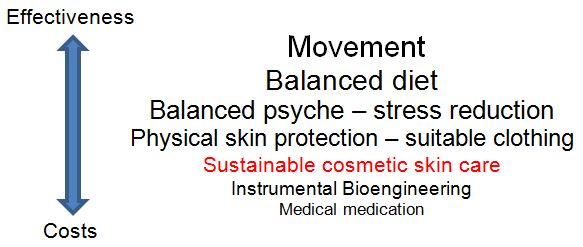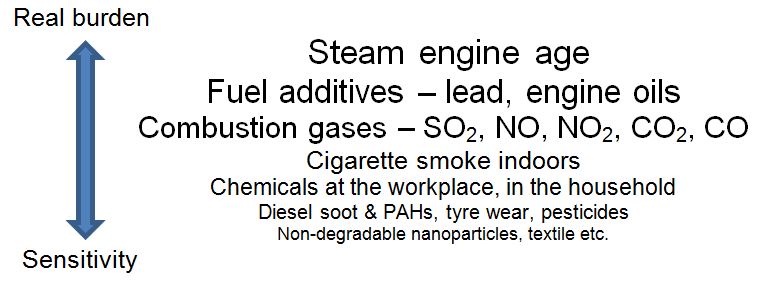It is no secret that evidence and studies conducted on anti-aging, among other things, are usually flawed. A corresponding statistic can be found in an article by J. Ionannidis "Why most published research findings are false (PLoS Medicine 2005(2); 8:e124)". How realistic is anti-aging really and which concepts are really effective?
Anti-aging – more than just wrinkle reduction
Cosmetic treatments aside: What actually makes an aging person "forever young" for those around them? Good and individually expressive appearance, varied interests, curiosity and open-mindedness for new things, an own opinion and clear positioning, physical activity and fitness as well as social and professional networking with people of all ages are definitely part of it.
In addition, it can be stated:
- Exercise not only keeps muscles, connective tissue and the physique fit, but also the skin firm and elastic.
- Stress and lack of sleep hinder revitalisation.
- The inner psyche with the fear of no longer being attractive due to advancing age functions like a self-fulfilling prophecy. There is a positive feedback between expectation and behaviour.
- The skin is a mirror of nutrition. Over-nutrition has similar effects as over-care. Incorrect nutrition has the same effect as inappropriate care.
- Smoking and alcohol damage the skin.
The relation between effectiveness and costs of the known activities against premature skin aging is remarkable (see graph):

Sustainable cosmetic skin care is therefore only in fifth place on the scale. But what makes skin care sustainable?
Temporary anti-aging ingredients
So that there are no misunderstandings: Non-sustainable does not necessarily mean superfluous, as the following examples of temporarily effective bases and components show:
- Occlusive creams – conventional principle of night creams using paraffins, earth waxes (ozokerite) and long-chain silicones – wrinkle-reducing.
- Occlusive, hardening masks – smoothing
- Pigments with increased diffusing light reflection – contrast-reducing
- Make-up – covering foundations
- Camouflage – opaque
- Dihydroxyacetone (self-tanning agent) – contrast-reducing in the case of redness and pigmentation disorders.
- Hyaluronic acid – plumping and firming
- Acylamino acids and protein hydrolysate condensates – firming
- Tranexamic acid – against redness
- Peptides (e.g. acetyl-glutamic acid-glutamic acid-methionine-glutamine-arginine-arginine) – influence on muscle contraction of wrinkles
- Spilanthol (paracress) – influence on the muscle contraction of wrinkles
- Kigelia extract (sausage tree) – skin tightening through flavones and saponins
- Centella asiatica (tiger grass) – skin tightening
- Saponins such as ruscin (butcher's broom), aescin (chestnut), equisetonin (horsetail) have a tonic effect on superficial vessels – used for dark circles, oedema, rosacea (vitamin K substitute).
- Caffeine and green tea – influence on local microcirculation
Sustainable anti-aging active ingredients
Examples of regenerative agents:
- Phosphatidylcholine (PC) – influence on ceramide metabolism
- DMAE (2-dimethylaminoethanol) – PC degradation product with a firming and wrinkle-reducing effect.
- Peptides (e.g. palmitoyl-lysine-threonine-threonine-lysine-serine) – stimulation of collagen synthesis
- Vitamin A, retinoids and derivatives – stimulation of growth factors
- B vitamins – stimulation of growth factors
- Vitamin C phosphate – stimulation of collagen synthesis
- Growth factors, e.g. EGF (epidermal growth factor)
- N-Acetyl-Glucosamine – hyaluronic acid substrate
- Essential fatty acids – metabolism activation, anti-inflammation
- EGCG (epigallocatechin gallate) – filaggrin stimulation, collagenase inhibition
- Isoflavonoids ("phytohormones") – binding to oestrogen receptors; skin smoothing, perioral hair growth inhibition, lipolysis (with devices).
- Fruit acids – wrinkle reducing. Side effects with continued use: perioral dermatitis (POD), rosacea-promoting.
- Massages with vegetable oils and lamellar creams
- Zinc salts: substrates for oxidoreductases, including superoxide dismutase (SOD) – metabolic activation, antimicrobial
Examples of skin-protecting active ingredients:
- Barrier-active components: ceramides, phytosterols (cholesterol substitute), long-chain fatty acids, squal(e,a)ne
- Linoleic acid – ceramide I substrate (elasticity of the skin barrier)
- Hydrogenated phosphatidylcholine – ceramide substitution in lamellar creams
- Amino acids, urea, glycerine, mineral salts, glycerophosphatidylcholine (GPC), ectoine, glycols – increase skin hydration.
- Film-forming, permeable polysaccharides such as hyaluronic acid, alginates, CM-glucan (also photoprotective with UV-A [radical scavenger]).
- Antioxidants: Vitamins A, E, C, isoflavonoids, resveratrol, OPC (oligomeric proanthocyanidins), lipoic acid, glutathione, coenzyme Q10 (in reduced form) in appropriate (!) concentrations. Not suitable for healing (e.g. blue and red light) and deliberate pigmentation processes, which are all radical (!). Polyphenols also have an antimicrobial effect.
- Protection from radiation: UV filters convert radiation into heat. Antioxidant additives are counterproductive for melanin formation, are very short-lived when exposed to radiation and form radical chain reactions in higher concentrations.
- Protection against pigmentation: inhibition of tyrosinase and melanin formation by vitamin C-phosphate, tranexamic acid.
- Protection against dandruff: Clotrimazole (INN), piroctone-olamine (INN)
Special synthetic anti-pollution agents are superfluous when using the aforementioned skin-protecting agents. Example: Benzylidene dimethoxydimethylindanone (INCI) is a blue light absorber and competitive aryl hydrocarbon receptor (AHR) antagonist. It prevents the release of inflammation-inducing cytokines and matrix metalloproteinases by polycyclic aromatic hydrocarbons (PAH). In this regard, the history of real environmental exposures and the increasing, culture-based sensitivity of humans is instructive:
 Examples of problem-solving agents: Examples of problem-solving agents:
- Aloe vera – soothing, anti-inflammatory, increase in skin hydration.
- Azelaic acid – antimicrobial (against anaerobes): Use for acne, rosacea, perioral dermatitis (POD).
- Betulinic acid – antimicrobial, apoptosis of melanoma cells
- Boswellic acids – protease inhibitors for skin care in acne, rosacea and actinic keratosis
- Echinacea (coneflower) – inhibition of hyaluronidase, care for rosacea, sunburn
- Essential fatty acids (flax, kiwi, rosehip) – 15-lipoxygenase substrates (anti-inflammatory metabolites)
- Gamma-linolenic acid (evening primrose) – atopic skin, neurodermatitis with a delta-6-desaturase defect
- Witch hazel – anti-inflammatory, mild astringent tannins
- 5-Lipoxygenase inhibitors – anti-inflammatory caffeic acid, curcumin, hyperforin, 3-O-acetyl-11-keto-ß-boswellic acid (in vitro data only).
- Phosphatidylcholine (liposomes, nanodispersions) – anti-inflammatory
- Phosphatidylserine – macrophage activation
- Provitamin B5 (D-panthenol) – irritated skin, soreness
- Salicylic acid – antimicrobial, keratolytic (impure skin, acne)
- Sphingosine-1-phosphate – inhibition of keratinocyte proliferation in psoriasis
- Tranexamic acid – stabilises capillary vessels in rosacea and couperosis
- Vitamin B3 (niacinamide) – anti-inflammatory (blemished skin, acne)
The effects of anti-aging products range from temporary to lasting. To increase the effects, there are various ways of optimisation.
Optimisation through combination
Anti-aging ingredients, preparations and treatments should match each other:
- Body cleansing with mild surfactants (low critical micelle formation concentration).
- Protective preparations with physiologically degradable emulsifiers or physiological hydrogenated phosphatidylcholine to minimise wash-out effects.
- Treatment procedures with the same bases, e.g. lamellar creams
- Combination of temporary and sustainable active substances with the exclusion of counterproductive components and auxiliary substances
Further optimisation is achieved by using skin probes to measure skin fat & sebum (lipid mantle), skin hydration, TEWL (transepidermal water loss), skin pH (acid mantle), skin elasticity, pigmentation and cameras, which allow for a sound skin analysis and tracking of treatment results over time.
The combination of preparations with devices such as radiofrequency (monopolar), mesoporation (pulsed electric fields), iontophoresis, infrared waves, ultrasound, shock waves, mesotherapy (microinjections), dermal needling, and steaming accelerates the penetration and permeation of active substances. The time between application and onset of action can be reduced to a minimum.
In addition, stimulating microcirculation and increasing skin elasticity through massage, physiotherapy, exercise and cold showers (release of adrenal hormones) are helpful.
Optimisation through networking
Knowledge of dermatological indications, cooperation with dermatological practices and appropriate, adjuvant corneotherapy with base creams that ideally comply with both the European Cosmetic Regulation and the German Pharmacy Operating Regulation (ApBetrO) as well as the European Pharmacopoeia (Ph. Eur.) are essential prerequisites for holistic success. Examples are:
- Therapeutic hormone treatments with oestrogens and cosmetic care with isoflavonoids (phytohormones)
- Acne treatments with vitamin A acid (therapeutic) and vitamin A and azelaic acid (cosmetic preventive).
- Care of atopic skin with gamma-linolenic acid in the case of a delta-6-desaturase enzyme defect
- Modular systems allow medicinal substances (pharmacy) and cosmetic active ingredient concentrates (beauty institutes) to be incorporated into the same base creams.
 Optimisation of the symbiosis Optimisation of the symbiosis
The skin flora aka microbiome makes a significant contribution to skin health and the maintenance of skin condition – including the acid mantle. Accordingly, the ingredients of preparations should be physiologically compatible and biodegradable. The symbiosis between the epidermis and the microbiome is severely disturbed by excessive hygiene and cosmetic additives, in particular:
- Preservatives, but also strong
- chelating agents such as EDTA and
- high antioxidant concentrations and
- buffered pH settings that are outside the physiological skin pH values.
The reduction of synergistic germ populations and the formation of resistant facultative pathogens must be avoided.
Optimisation through personalisation
Modular cosmetics are the key to sustainable anti-aging. Base creams, gels and lotions are individually equipped on site with only the (registered) active ingredient concentrates/serums that are actually needed. Counterproductive components can be omitted. The associated personal visual inspection in the institute and the careful skin analysis are decisive prerequisites for the success of the treatment
Dr Hans Lautenschläger
|

